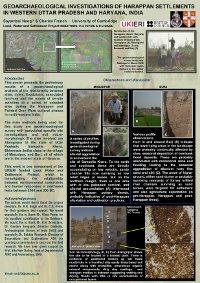| Authors | Sayantani Neogi, Charles French |
| Title | Geoarchaeological Investigations of the Late Harappan Urabn Settlements in Western Uttar Pradesh and Haryana |
Abstract
This paper presents preliminary results of the geoarchaeological investigations of soil/sediment sequences associated with a series of late Harappan archaeological sites in northwest India dated to between c. 2000 and 300 BC, namely at Alamgirpur in western Uttar Pradesh and Masudpur I (Sampolia Khera) and Masudpur VII (Bhimwada Jhoda) in Haryana. This period is particularly important because it was a time when the urban Indus Civilisation had declined and its major cities were abandoned, and it was not for c. 1000 years that large urban centers re-emerged in the Ganges Region. This study should provide new understandings of the pre-existing and contemporary associated landscapes as well as site formation processes, thereby helping to understand both human impacts on this landscape and human responses to environmental change, and how a new cultural epoch may have developed from the previous one. Thin section slides for micromorphological analysis from Alamgirpur, Sampolia Khera and Bhimwada Jodha have been prepared at the McBurney Geoarchaeology Laboratory (Dept of Archaeology, University of Cambridge). Initial analysis is beginning to reveal some exciting results about soil formation processes with inferences for the nature of developing relationships between the humans and their environment. For example, it is apparent that the sites are built on former floodplains which are no longer affected by seasonal inundation and alluvial deposition. This has wide-ranging and long-term implications for nature of the agricultural basis of these sites, and also serves to corroborate some of the geomorphological findings of other team members.
